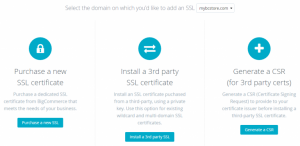The following instructions will guide you through the SSL installation process on BigCommerce. If you have more than one server or device, you will need to install the certificate on each individual server or device you need to secure. If you still have not generated your certificate and completed the validation process, reference our CSR Generation Instructions and disregard the steps below.
What You’ll Need
-
Your server certificate
This is the certificate you received from the CA for your domain. You may have been sent this via email. If not, you can download it by visiting your Account Dashboard and clicking on your order.
-
Your intermediate certificates
These files allow the devices connecting to your server to identify the issuing CA. There may be more than one of these certificates. If you got your certificate in a ZIP folder, it should also contain the Intermediate certificates, which is sometimes referred to as a CA Bundle. If not, download the appropriate CA Bundle for your certificate.
-
Your private key
This file should be on your server, or in your possession if you generated your CSR from a free generator tool. On certain platforms, such as Microsoft IIS, the private key is not immediately visible to you but the server is keeping track of it
Installation Instructions
-
-
Access Server Settings
In the BigCommerce control panel, select Server Settings
-
Add a 3rd Party SSL Certificate
Select SSL Certificate, then click “Add a 3rd Party”
-

-
-
Copy and Paste
Copy and paste your SSL Certificate and any accompanying intermediates in to their respective fields
-
Install
Click Install, your certificate should be installed within 20 minutes
-

Congratulations! You’ve successfully installed your SSL certificate! To check your work, visit the website in your browser at https://yourdomain.tld and view the certificate/site information to see if HTTPS/SSL is working properly. Remember, you may need to restart your server for changes to take effect.
To check your server’s configurations more thoroughly, use our SSL Checker Tool or contact our Customer Experience Department for additional assistance.
